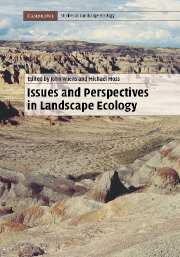Book contents
- Frontmatter
- Contents
- List of contributors
- Preface
- PART I Introductory perspectives
- PART II Theory, experiments, and models in landscape ecology
- PART III Landscape patterns
- PART IV Landscape dynamics on multiple scales
- PART V Applications of landscape ecology
- PART VI Cultural perspectives and landscape planning
- 26 The nature of lowland rivers: a search for river identity
- 27 Using cultural knowledge to make new landscape patterns
- 28 The critical divide: landscape policy and its implementation
- 29 Landscape ecology: principles of cognition and the political–economic dimension
- 30 Integration of landscape ecology and landscape architecture: an evolutionary and reciprocal process
- 31 Landscape ecology in land-use planning
- PART VII Retrospect and prospect
- Index
- Plate section
- References
28 - The critical divide: landscape policy and its implementation
from PART VI - Cultural perspectives and landscape planning
Published online by Cambridge University Press: 20 November 2009
- Frontmatter
- Contents
- List of contributors
- Preface
- PART I Introductory perspectives
- PART II Theory, experiments, and models in landscape ecology
- PART III Landscape patterns
- PART IV Landscape dynamics on multiple scales
- PART V Applications of landscape ecology
- PART VI Cultural perspectives and landscape planning
- 26 The nature of lowland rivers: a search for river identity
- 27 Using cultural knowledge to make new landscape patterns
- 28 The critical divide: landscape policy and its implementation
- 29 Landscape ecology: principles of cognition and the political–economic dimension
- 30 Integration of landscape ecology and landscape architecture: an evolutionary and reciprocal process
- 31 Landscape ecology in land-use planning
- PART VII Retrospect and prospect
- Index
- Plate section
- References
Summary
Forecasts made in planning policy are rarely achieved in the practicalities of local application, and the case for landscape conservation is no exception. The critical divide between landscape policy developed by upper-tier government agencies and the implementation of those conservation measures at a local level is a phenomenon common to many locations. A specific case of this divide was studied in Ontario, Canada over a span of time between the passing and defeat of one planning act and the introduction of another. Through a series of interviews conducted with both the creators and the future implementers of the landscape policy in those acts, central issues that contribute to conservation resistance were examined. This qualitative study compares the responses, identifies the differences, and in the end suggests strategies that may be useful to other jurisdictions to help foster a better land-use planning environment for landscape interpretation, use, and protection in the development process.
The concept of landscape: theory and application
“Landscape” is an idea that has a long tradition in academic literature (Sauer, 1925; Hartshorne, 1939; Hoskins, 1969; Meinig, 1979; Cosgrove, 1984; Schama, 1995). Interest in the concept's utility for planning has grown in the last decade (Mitchell et al., 1993; Maines and Bridger, 1992; Watson and Labelle, 1997; Cardinall and Day, 1998; Rydin, 1998; McGinnis et al., 1999). It has been acknowledged that it can serve as a basis from which planners can integrate natural and cultural elements and issues – historically, two realms polarized from each other (Olwig, 1996).
- Type
- Chapter
- Information
- Issues and Perspectives in Landscape Ecology , pp. 281 - 295Publisher: Cambridge University PressPrint publication year: 2005

